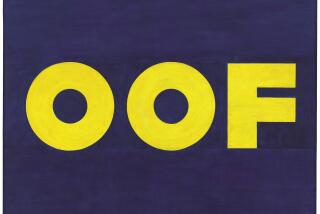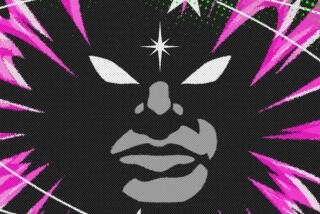Mark Cohen; Collected Mad Magazine Artwork
Mark Jeffrey Cohen had been a social historian all his life.
Or not.
What he did was lecture on the life and times of Alfred E. Neuman and collect original art from Mad magazine, the home of the whimsical imp since 1955. Cohen also collected a lot of comic books and original cartoons and lectured on their meaning.
“Mad is essentially a social history of the United States from a satirical point of view,” Cohen explained repeatedly in 1996 during a national exhibition tour of the loopiest portions of his Mad memorabilia.
“People of my generation learned their first politics from Mad,” he said. “It started out by attacking McCarthyism and was one of the few publications that had the guts to do so. Its publisher, Bill Gaines, was hauled before a Senate committee on juvenile delinquency . . . [for purportedly] corrupting the nation’s youth.”
Cohen, who was 57, died of lung cancer Dec. 19 at his Santa Rosa, Calif., home.
Two years ago, Cohen, who was once a heavy smoker, sold several dozen of his collection’s editorial cartoons featuring Joe Camel, the controversial cigarette advertisement icon, and donated a portion of the proceeds to the American Cancer Society.
During a lifetime of collecting, the Stockton-born Cohen amassed about 3,000 autographed comic books and hundreds of cartoon-related items, which he gave to the National Cartoonists Society archives housed at Ohio State University. Last year, he went on a lecture and exhibit tour with some of those items. It was billed as “The Comic Pages: A Social History Cartoon Art Exhibition.”
But Cohen’s first love was Mad, and he collected about 9,500 pieces of its original art, one of the largest such collections in the world.
“The biggest thing was how much you could actually learn about the world from Mad. They never dumbed anything down. Their message was: Don’t trust everything you see, read and hear,” Cohen said during his 1996 tour, dubbed “Humor in a Jugular Vein: The Art, Artists and Artifacts of Mad Magazine.”
Cohen was 13 when the magazine began, and he madly collected every issue for the first 10 years. Then he moved away from home.
His mother threw out the collection.
He acquired a second complete set of Mad.
His first wife got those in their divorce.
It was then that Cohen adopted Neuman’s oft-quoted philosophy, “What, me worry?” and stopped looking for the magazine issues. Instead he concentrated on collecting original Mad drawings, paintings, sketches and toys--a project made easier in 1989 when founder Gaines began auctioning the publication’s artwork.
Cohen’s favorite piece was the cover painting for Mad’s fifth anniversary, which featured 95 trademark icons of the 1950s in watercolor, pencil and India ink.
He had wanted to be a cartoonist himself, but was told by an editorial cartoonist viewing his work that he didn’t have the talent.
So Cohen supported his collecting habit as a real estate agent and a cartoonists agent, representing such luminaries as Charles Schulz of “Peanuts,” Lynn Johnson of “For Better or Worse,” Greg Evans of “Luann,” and Jim Bergman and Jerry Scott of “Zits,” as well as single-panel satirists who published cartoons in such magazines as the New Yorker and Playboy.
Cohen also wrote for comic strips, including “Gasoline Alley,” “Popeye” and “Wee Pals,” and for various comic books.
Along the way, he became an expert on comic book, comic strip and cartoon art, on Mad magazine, and particularly on its poster boy, Alfred E. Neuman.
Mad did not originate the gap-toothed character, Cohen told The Times in 1998, although Neuman was with the magazine from its inception. An early editor, Harvey Kurtzman, found the image and put it, as refined by artist Norman Mingo, on the first issue in 1955.
The earliest known image of Neuman, Cohen said, was painted on the side of a 19th century traveling dentist’s wagon with the slogan “It didn’t hurt a bit.” The face also appeared on political ads during President Franklin D. Roosevelt’s final campaign, he said, with the caption “Me worry? I’m in favor of a fourth term.”
When Mad adopted Neuman as its official mascot in the mid-1950s, the magazine was sued for copyright infringement by Helen Pratt Stuff, whose husband, Harry Spencer Stuff, had copyrighted the image in 1911. She won a couple of suits, but they were overturned after Mad proved that earlier images of the character existed.
As for comic strips, Cohen often said, the first to appear in a newspaper was officially “The Yellow Kid” in 1895. But he considered the origin of comics to be in prehistoric times.
“The first cartoonists were cavemen,” Cohen said. “They would write a story with a series of pictures. That’s called sequential art.”
Comics and cartoons, like cave art, Cohen pointed out, mirror the society of the time they’re drawn in--including the style of clothing, transportation, major events such as war, and even societal attitudes and prejudices.
“It’s an obsession,” Cohen conceded last year about his addiction to cartoon art. “It’s an illness, and I love it.”
He is survived by his wife, Rose Marie McDaniel; two sons, Eric and Jeffrey; a daughter, Marsha Christmann; and a sister, Rochelle Warnier.
More to Read
The biggest entertainment stories
Get our big stories about Hollywood, film, television, music, arts, culture and more right in your inbox as soon as they publish.
You may occasionally receive promotional content from the Los Angeles Times.










